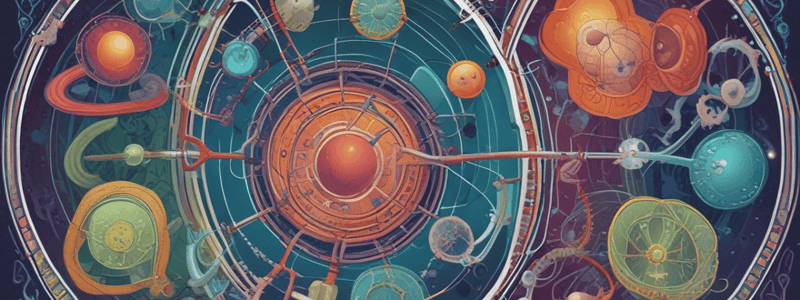Podcast
Questions and Answers
What happens when a proto-oncogene mutates or becomes overactive?
What happens when a proto-oncogene mutates or becomes overactive?
- It promotes cell death (apoptosis).
- It transforms into an oncogene, causing cells to divide out of control. (correct)
- It stops cells from growing and dividing.
- It becomes a tumor suppressor gene.
How can gene variants/mutations contribute to proto-oncogenes becoming oncogenes?
How can gene variants/mutations contribute to proto-oncogenes becoming oncogenes?
- By activating proto-oncogenes. (correct)
- By causing DNA sequence changes during cell division.
- By preventing chemical modifications.
- By turning off the gas pedal.
Which process can turn on proto-oncogenes without altering the gene sequence?
Which process can turn on proto-oncogenes without altering the gene sequence?
- Chromosome rearrangements
- Tumor suppression
- Epigenetic changes (correct)
- Gene recombination
What is the role of tumor suppressor genes in cell growth?
What is the role of tumor suppressor genes in cell growth?
Which component is critical for proto-oncogenes to function as 'gas pedals' in cell growth?
Which component is critical for proto-oncogenes to function as 'gas pedals' in cell growth?
How does the activation of MPF influence the cell cycle progression?
How does the activation of MPF influence the cell cycle progression?
What type of mutation involves big rearrangements of DNA segments, like genetic remodelling projects?
What type of mutation involves big rearrangements of DNA segments, like genetic remodelling projects?
Which type of small-scale mutation involves adding or removing nucleotide pairs, similar to editing a sentence by adding or deleting words?
Which type of small-scale mutation involves adding or removing nucleotide pairs, similar to editing a sentence by adding or deleting words?
In a substitution mutation, what happens when a single nucleotide pair is changed in the genetic code?
In a substitution mutation, what happens when a single nucleotide pair is changed in the genetic code?
What type of mutation does not change the protein's appearance but may transform one codon into another that still codes for the same amino acid?
What type of mutation does not change the protein's appearance but may transform one codon into another that still codes for the same amino acid?
Which type of small-scale mutation might result in a protein with a new amino acid that behaves similarly to the old one?
Which type of small-scale mutation might result in a protein with a new amino acid that behaves similarly to the old one?
Imagine a mutation where one codon is changed into another that codes for a different amino acid. This is an example of:
Imagine a mutation where one codon is changed into another that codes for a different amino acid. This is an example of:
What is the consequence of a frameshift mutation near the end of a gene?
What is the consequence of a frameshift mutation near the end of a gene?
How do insertions and deletions outside of coding regions impact gene expression?
How do insertions and deletions outside of coding regions impact gene expression?
In sickle-cell disease, what specific type of mutation occurs in the DNA?
In sickle-cell disease, what specific type of mutation occurs in the DNA?
What is the consequence of the mutation in the beta-globin gene in sickle-cell disease?
What is the consequence of the mutation in the beta-globin gene in sickle-cell disease?
What happens when altered hemoglobin in sickle-cell disease encounters low oxygen levels?
What happens when altered hemoglobin in sickle-cell disease encounters low oxygen levels?
How does a premature termination occur in relation to nonsense mutations?
How does a premature termination occur in relation to nonsense mutations?
Flashcards are hidden until you start studying



